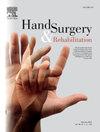Antibiotic prophylaxis and other factors influencing infection risk reduction in hand and forearm fracture surgery: A narrative review
IF 1
4区 医学
Q4 ORTHOPEDICS
引用次数: 0
Abstract
Surgical site infection is a serious complication of fracture surgery that often requires antibiotic treatment, implant removal, and wound debridement. Antibiotic prophylaxis is one of the measures taken to reduce the risk of surgical site infection. Other factors influencing the risk of infection include leaving the ends of the K-wires protruding through the skin vs. buried under the skin, operating under full sterility vs. field sterility in the operating room, or the burden of comorbidities.
The purpose of this study was to review the current literature on antibiotic prophylaxis and other factors that influence the risk of infection during surgery for hand and distal radial fractures. We also reviewed the literature on potential adverse effects and costs of antibiotic prophylaxis.
Results. Three studies and one systematic review were identified for the operative treatment of closed hand and distal radius fractures, none of which supported the routine use of antibiotic prophylaxis. For leaving the ends of K-wires exposed versus burying them under the skin, two articles were found. One reported an increased risk of surgical site infection when K-wires are left exposed, and the other reported that it does not matter.
Three studies reported harmful and adverse effects of unnecessary use of antibiotic prophylaxis. Two studies reported an increased risk of surgical site infection in patients with comorbidities, compromised immunity, smoking, and alcohol use. The routine use of antibiotic prophylaxis generates significant costs that can be avoided if it is used as recommended by evidence-based medicine.
Conclusion. The authors believe that this review may have many beneficial effects for patients and the health care system, such as: preventing bacterial resistance, increasing the efficacy of antibiotics in true infections, reducing the risk of adverse reactions, and reducing health care costs.
抗生素预防和其他影响手部和前臂骨折手术感染风险降低的因素:叙述性回顾。
手术部位感染是骨折手术的严重并发症,通常需要抗生素治疗、移除植入物和伤口清创。抗生素预防是减少手术部位感染风险的措施之一。其他影响感染风险的因素包括将克氏针的末端从皮肤中伸出还是埋在皮肤下,在手术室中完全无菌还是野外无菌操作,或者合并症的负担。本研究的目的是回顾目前关于手部和桡骨远端骨折手术中抗生素预防和其他影响感染风险因素的文献。我们还回顾了有关抗生素预防的潜在不良反应和成本的文献。结果。3项研究和1项系统综述确定了闭合性手和桡骨远端骨折的手术治疗,没有一项研究支持常规使用抗生素预防。对于将k线的末端暴露在外与将其埋在皮肤下,发现了两种物品。一份报告称,当k线暴露在外时,手术部位感染的风险增加,而另一份报告称这无关紧要。三项研究报告了不必要使用抗生素预防的有害和不良影响。两项研究报告了合并症、免疫力低下、吸烟和饮酒患者手术部位感染的风险增加。常规使用抗生素预防会产生巨大的费用,如果按照循证医学的建议使用,则可以避免这种费用。结论。作者认为,这一综述可能对患者和卫生保健系统有许多有益的影响,如:预防细菌耐药性,提高抗生素在真感染中的疗效,降低不良反应的风险,降低卫生保健费用。
本文章由计算机程序翻译,如有差异,请以英文原文为准。
求助全文
约1分钟内获得全文
求助全文
来源期刊

Hand Surgery & Rehabilitation
Medicine-Surgery
CiteScore
1.70
自引率
27.30%
发文量
0
审稿时长
49 days
期刊介绍:
As the official publication of the French, Belgian and Swiss Societies for Surgery of the Hand, as well as of the French Society of Rehabilitation of the Hand & Upper Limb, ''Hand Surgery and Rehabilitation'' - formerly named "Chirurgie de la Main" - publishes original articles, literature reviews, technical notes, and clinical cases. It is indexed in the main international databases (including Medline). Initially a platform for French-speaking hand surgeons, the journal will now publish its articles in English to disseminate its author''s scientific findings more widely. The journal also includes a biannual supplement in French, the monograph of the French Society for Surgery of the Hand, where comprehensive reviews in the fields of hand, peripheral nerve and upper limb surgery are presented.
Organe officiel de la Société française de chirurgie de la main, de la Société française de Rééducation de la main (SFRM-GEMMSOR), de la Société suisse de chirurgie de la main et du Belgian Hand Group, indexée dans les grandes bases de données internationales (Medline, Embase, Pascal, Scopus), Hand Surgery and Rehabilitation - anciennement titrée Chirurgie de la main - publie des articles originaux, des revues de la littérature, des notes techniques, des cas clinique. Initialement plateforme d''expression francophone de la spécialité, la revue s''oriente désormais vers l''anglais pour devenir une référence scientifique et de formation de la spécialité en France et en Europe. Avec 6 publications en anglais par an, la revue comprend également un supplément biannuel, la monographie du GEM, où sont présentées en français, des mises au point complètes dans les domaines de la chirurgie de la main, des nerfs périphériques et du membre supérieur.
 求助内容:
求助内容: 应助结果提醒方式:
应助结果提醒方式:


